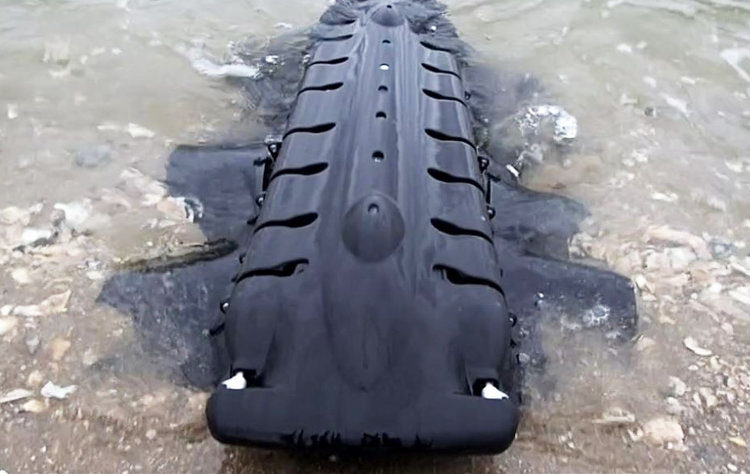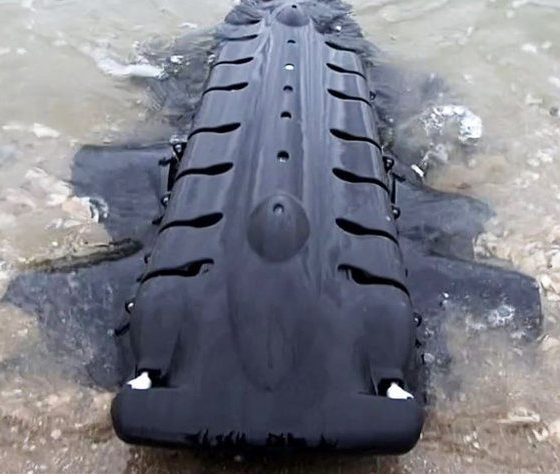

News
Three creepy, yet useful robots for rescue missions and deep space travel
Whether or not you welcome humanity’s coming overlord robots, there’s something entertaining about watching them grow up. We’ve all seen Boston Dynamics release one video after the other displaying their robot dogs trotting around opening doors and their humanoid bots overcoming obstacle courses while being abused by their human creators (p.s. they won’t forget). However, they’re not the only company with some interesting, impressive, and somewhat creepy robotic developments. Here are three we thought should be on your radar:
Robugtix Z6 Spider-Bot
This little spider-like guy made some waves at the end of this month with its coordinated dance moves shown off in an 80s-style aerobics video. Its maker is Hong Kong-based robotics company Robugtix, and apparently they have a strong preference for arachnids in their designs. The Z6 has three other siblings in the family, all spider-like in their design as well, and all movie stars in their own right.

Described as “portable and foldable…for use in professional environments”, the Z6 boasts the ability to climb stairs, fold up into a compact/backpack size, roll over, right itself if upside down, and navigate in confined spaces and irregular terrain. A built-in camera provides video streaming and monitioring from its wireless joystick controller. At its smallest, the Z6 is 10 cm (L) x 23 cm (W) x 13.7 cm (H); default standing mode is 52 cm (L) x 49 (W) cm x 17 cm (H). Given the capabilities, some industrial applicability may be in the works, i.e., search and rescue assistance.
Looking for a price? You might not want to ask just yet, and you’ll have to if you want to know for sure. Its siblings range from around $1000 (T8X) to $40,000 (RoboNOBE Black Widow), so we can only guesstimate what this (-tiny-) compact dancer’s cash money trade value will be.
To see the Z6’s awesome dance moves, watch the video below:
Velox by Pliant Energy Systems
This robot actually evolved from research into renewable energy, specifically capturing wave and tidal energy. CEO Pietro Filardo of Pliant Energy Systems, the maker of Velox and based in New York, used his background in marine biology to design biomorphic devices that could not only capture energy from aquatic sources but also propel them. As seen by the ribbon-like attachments directing the bot’s motion, the final design involved a flexible fin moving in wave motions driven by internal actuators. With a few extra degrees of motion, Velox can also move across solid surfaces include sand, snow, pebbles, paving, and solid ice. To quote its makers, it can “swim like a ray, crawl like a millipede, jet like a squid, and slide like a snake.”

Pliant apparently has big plans for Velox’s eventual prodigy. The company’s website lists stealth characteristics and maneuverability useful for surf zone, amphibious beach, and polar ice missions – an obvious military appeal that’s not surprising considering the partial funding received from the U.S. Office of Naval Research, an organization within the Department of the Navy. Civilian uses are also suggested, if its proof-of-concept videos aren’t imagination-inspiring enough, such as personal propulsion for divers, propeller replacement for environmentally-sensitive waters like coral reefs, and search and rescue operations, specifically in the case of thin ice fall victims.
The company has been developing patented technologies since 2007 and its research has been sponsored by a variety of local and federal agencies including the National Science Foundation and U.S. Department of Agriculture. Pliant’s novel fin system (“undulating”, i.e., smooth and wavy) is also being applied towards its original intention – water energy generation – for which its design is useful where dams are not practical or desirable. Velox itself is still in the proof-of-concept stage, but its capabilities are already on display for admiration.
Watch the below video to see Velox in action:
Robotic Skins by Yale University
Admittedly, these devices aren’t actually robots but rather make things into robots. Designed by Yale University as a NASA initiative, “robotic skins” are sheets of elastic material with robot components embedded inside, i.e., actuators and sensors. When wrapped around compatible objects, they provide movement and sensing functionality as needed to perform tasks.
Deep space traveling was the inspiration for their design – preparing for the unknown. If travelers can’t be sure what robotic functionality will be needed in a somewhat unpredictable environment, it would be useful to have the ability to create what’s needed on-demand. Demonstrations of the skins thus far have included a stuffed horse walking, a cylinder crawling like a worm, a claw for moving things, and a posture sensor that vibrates when a user is slouching. Perhaps implementing multiple skins could create a bot that both flipped pages in a spacecraft instruction manual and slapped the reader when they stopped paying attention. Hey, deep space might also be boring.
Watch the below video for more on how these “robotic skins” work:

News
Tesla FSD fleet is nearing 7 billion total miles, including 2.5 billion city miles
As can be seen on Tesla’s official FSD webpage, vehicles equipped with the system have now navigated over 6.99 billion miles.

Tesla’s Full Self-Driving (Supervised) fleet is closing in on almost 7 billion total miles driven, as per data posted by the company on its official FSD webpage.
These figures hint at the massive scale of data fueling Tesla’s rapid FSD improvements, which have been quite notable as of late.
FSD mileage milestones
As can be seen on Tesla’s official FSD webpage, vehicles equipped with the system have now navigated over 6.99 billion miles. Tesla owner and avid FSD tester Whole Mars Catalog also shared a screenshot indicating that from the nearly 7 billion miles traveled by the FSD fleet, more than 2.5 billion miles were driven inside cities.
City miles are particularly valuable for complex urban scenarios like unprotected turns, pedestrian interactions, and traffic lights. This is also the difference-maker for FSD, as only complex solutions, such as Waymo’s self-driving taxis, operate similarly on inner-city streets. And even then, incidents such as the San Francisco blackouts have proven challenging for sensor-rich vehicles like Waymos.
Tesla’s data edge
Tesla has a number of advantages in the autonomous vehicle sector, one of which is the size of its fleet and the number of vehicles training FSD on real-world roads. Tesla’s nearly 7 billion FSD miles then allow the company to roll out updates that make its vehicles behave like they are being driven by experienced drivers, even if they are operating on their own.
So notable are Tesla’s improvements to FSD that NVIDIA Director of Robotics Jim Fan, after experiencing FSD v14, noted that the system is the first AI that passes what he described as a “Physical Turing Test.”
“Despite knowing exactly how robot learning works, I still find it magical watching the steering wheel turn by itself. First it feels surreal, next it becomes routine. Then, like the smartphone, taking it away actively hurts. This is how humanity gets rewired and glued to god-like technologies,” Fan wrote in a post on X.
News
Tesla starts showing how FSD will change lives in Europe
Local officials tested the system on narrow country roads and were impressed by FSD’s smooth, human-like driving, with some calling the service a game-changer for everyday life in areas that are far from urban centers.

Tesla has launched Europe’s first public shuttle service using Full Self-Driving (Supervised) in the rural Eifelkreis Bitburg-Prüm region of Germany, demonstrating how the technology can restore independence and mobility for people who struggle with limited transport options.
Local officials tested the system on narrow country roads and were impressed by FSD’s smooth, human-like driving, with some calling the service a game-changer for everyday life in areas that are far from urban centers.
Officials see real impact on rural residents
Arzfeld Mayor Johannes Kuhl and District Administrator Andreas Kruppert personally tested the Tesla shuttle service. This allowed them to see just how well FSD navigated winding lanes and rural roads confidently. Kruppert said, “Autonomous driving sounds like science fiction to many, but we simply see here that it works totally well in rural regions too.” Kuhl, for his part, also noted that FSD “feels like a very experienced driver.”
The pilot complements the area’s “Citizen Bus” program, which provides on-demand rides for elderly residents who can no longer drive themselves. Tesla Europe shared a video of a demonstration of the service, highlighting how FSD gives people their freedom back, even in places where public transport is not as prevalent.
What the Ministry for Economic Affairs and Transport says
Rhineland-Palatinate’s Minister Daniela Schmitt supported the project, praising the collaboration that made this “first of its kind in Europe” possible. As per the ministry, the rural rollout for the service shows FSD’s potential beyond major cities, and it delivers tangible benefits like grocery runs, doctor visits, and social connections for isolated residents.
“Reliable and flexible mobility is especially vital in rural areas. With the launch of a shuttle service using self-driving vehicles (FSD supervised) by Tesla in the Eifelkreis Bitburg-Prüm, an innovative pilot project is now getting underway that complements local community bus services. It is the first project of its kind in Europe.
“The result is a real gain for rural mobility: greater accessibility, more flexibility and tangible benefits for everyday life. A strong signal for innovation, cooperation and future-oriented mobility beyond urban centers,” the ministry wrote in a LinkedIn post.
News
Tesla China quietly posts Robotaxi-related job listing
Tesla China is currently seeking a Low Voltage Electrical Engineer to work on circuit board design for the company’s autonomous vehicles.

Tesla has posted a new job listing in Shanghai explicitly tied to its Robotaxi program, fueling speculation that the company is preparing to launch its dedicated autonomous ride-hailing service in China.
As noted in the listing, Tesla China is currently seeking a Low Voltage Electrical Engineer to work on circuit board design for the company’s autonomous vehicles.
Robotaxi-specific role
The listing, which was shared on social media platform X by industry watcher @tslaming, suggested that Tesla China is looking to fill the role urgently. The job listing itself specifically mentions that the person hired for the role will be working on the Low Voltage Hardware team, which would design the circuit boards that would serve as the nervous system of the Robotaxi.
Key tasks for the role, as indicated in the job listing, include collaboration with PCB layout, firmware, mechanical, program management, and validation teams, among other responsibilities. The role is based in Shanghai.
China Robotaxi launch
China represents a massive potential market for robotaxis, with its dense urban centers and supportive policies in select cities. Tesla has limited permission to roll out FSD in the country, though despite this, its vehicles have been hailed as among the best in the market when it comes to autonomous features. So far, at least, it appears that China supports Tesla’s FSD and Robotaxi rollout.
This was hinted at in November, when Tesla brought the Cybercab to the 8th China International Import Expo (CIIE) in Shanghai, marking the first time that the autonomous two-seater was brought to the Asia-Pacific region. The vehicle, despite not having a release date in China, received a significant amount of interest among the event’s attendees.








